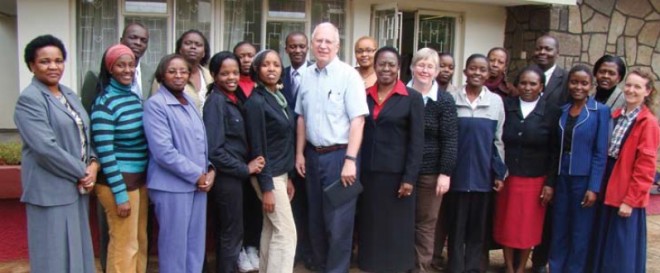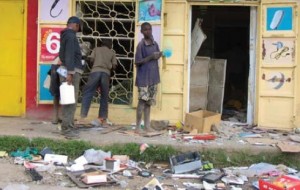
In recent years, Kenya looked as if it were going to be among those African countries in the forefront of finding their way toward national unity and social equity, with peace and prosperity as the ultimate outcomes.
Kenya’s peace was fragile, however, mostly because its economic gains were unequally distributed. When the violence erupted last December and January, some observers feared a Rwanda-like ethnic war. This didn’t happen. To repeat: the violence did not escalate into an all-out civil war. Kenya pulled back from the brink.
This is evidence that millions of Kenyans from all walks of life doubt violence will lead to the changes they desire. Church, school, health, refugee, and even military leaders in Kenya routinely use terms like “sustainable peace,” “reconciliation,” and “dialogue.”
Much of this awareness can be traced to CJP-trained people, who in turn have trained and reached out to thousands of others in Kenya. CJP folks, of course, do not work alone. They become employees, consultants, and partners with like-minded organizations, sometimes founding new ones.
“It’s hard to determine the full impact of CJP-trained people in Kenya during the post-election crisis,” says Janice Jenner, MA ’00, director of CJP’s Practice and Training Institute. “Clearly, though, the conflict-transformation skills taught at CJP do work in the ‘real world,’ as they did in Kenya.” Jenner and her husband Hadley were co-country representatives for Mennonite Central Committee in Kenya from 1989 to 1996.
Notice the language used by president Kibaki and opposition leader Odinga on January 24, when they shook hands, smiled and shared the same platform for the first time since the election was disputed. Beside them was a visibly pleased Kofi Annan. Out of the spotlight but nearby was EMU professor Hizkias Assefa, the mediation advisor for Annan’s successful peacemaking effort.
Both political leaders appealed for immediate calm, according to the BBC, with Kibaki pledging to rebuild destroyed homes and towns, resettle the displaced, and “do everything else possible to ensure Kenyans live as brothers.”
Odinga said his party was committed to peace, but stressed that to be sustainable, it had to be based on justice.
Annan summed up: “I think we have begun to take some first steps towards a peaceful solution of the problem, and as you can see, the two leaders are here to underline their engagement to dialogue and to work together for a just and sustainable peace.”
Over the next few months, Kenya’s government took new shape. Odinga filled the newly created position of second prime minister and the president’s cabinet was enlarged to make room for members appointed on the basis of their party’s numbers in Parliament.
“We can now consign Kenya’s past failures of grand corruption and grand tribalism to our history books,” Odinga said when he took office. “We will ensure that power, wealth and opportunity are [in] the hands of many, not the few.”
To reach these worthy goals, Kenya must navigate through minefields: a high rate of unemployment, budget deficits, poor infrastructure, corruption in the civil service… not to mention the still-simmering problems of refugees and ethnic tensions.
And here is where the people trained at CJP – and those who they, in turn, train; who in turn train others (it’s a multiplier effect) – come into play.
“Last spring when I was East Africa, I heard our graduates called the ‘EMU mafia,’” says Jenner. “It was meant as a compliment, in the sense that our extended family of peacebuilders has had a major impact on the easing of violent conflict in Africa.”
In a September 27, 2007, Washington Post article, reporter John Prendergast said that after spending 25 years writing about atrocities, tyranny and famine in Africa, he wanted to write about the “hope, self-transformation and inspiration” he was seeing of late, belying “outsiders’ low expectations for the continent.”
“Africans are demanding that their voices be heard – through the ballot box, through civil society organizations, new media, revitalized political parties, and reformed institutions to provide accountability,” Prendergast wrote.
Despite the temporary (one hopes) lapse in Kenya last year, Washington Post journalist Craig Timberg echoed Prendergast’s optimism about Africa in an article published March 13, 2008. “Peace, however fragile, is the norm rather than war,” he wrote, citing the growing vigor of civil society and democracy in Ghana, Benin, Sierra Leone, Liberia and Nigeria.
Here’s an example of how peace spreads: An organization called Oasis Africa, directed by Dr. Gladys Mwiti, has partnered with the Ford Foundation to train Nairobi high school teachers in trauma counseling. Dr. Mwiti came to EMU’s STAR program in 2004 . Later, she helped field-test and refine a training manual for Youth STAR (Strategies for Trauma Awareness and Resilience), funded by the U.S. Institute of Peace.
Oasis Africa agreed to pilot test the STAR manual with youth in a Nairobi slum, with “amazing outcomes,” according to the Oasis Africa newsletter.
The completed version of the Youth STAR manual arrived at Oasis Africa this year, when Jan Jenner and CJP director Lynn Roth visited Nairobi and hand-delivered the full STAR package to Dr. Mwiti. She and her staff are now using the manual in training about 114 teachers in 57 high schools in Nairobi.
“It is expected that each of the 114 teachers will train 30 peer counselors,” said the Oasis Africa newsletter. This means that about 3,420 peer counselors will be trained. Each peer counselor is “mandated” to pass along his or her training to at least 30 fellow students.

Here’s the math: more than 100,000 people will be impacted by Oasis Africa and its usage of the Youth STAR manual, developed by Vesna Hart (M.Ed.’04) at EMU with the help of Dr. Mwiti and many others. And this is just one of a dozen far-reaching programs in which our alumni are involved in Kenya.
Earlier versions of the trainings caused Kamiti High School, which was formerly conflict-ridden, to be “a shining example of the transformative power of this intervention,” said the newsletter. The current trainings are aimed at schools “situated in slums, such as Mathare, Kibera and Mukuru, the most affected communities during the post-election violence.”
The idea is to reach “the most needy and the most affected youth, and so hope to break the cycle of trauma and anger that may in the future become a brewing ground for community violence,” explained the Oasis Africa newsletter.
Oasis Africa doesn’t limit its work to schools. In response to post-election tension among its multi-ethnic employees, the management of the Coca-Cola bottling company in Nairobi endorsed a six-day program led by Oasis Africa that covered conflict resolution, peacebuilding, team building, and trauma healing. Many of the 600 Coca-Cola employees had been affected by the violence outside their workplace – injuries, loss of loved ones, loss of income and loss of their homes or other property – and they responded eagerly to the lessons offered in self- and communityhealing.
Trained peacebuilders also are working with churches in Kenya. For example, Charles Nyoike Ndegwa, MA ’05, gave a speech to 100 pastors at AIC Kijabe Mission Center in late February, just a few weeks after violence in the streets had ebbed. Ndegwa challenged them to pay attention to the early warning signs of upheaval – such as the tribal divisions evident in the 2004 national referendum on changing Kenya’s constitution – and “to be fully involved in looking for solutions to the problems facing our communities.”
“Burying the dead and distributing relief aid is not enough,” Ndegwa said. “Christians must do more to avert conflicts and violence… and that work should include confronting the powers that be.”
